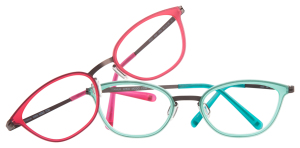 By Paddy Kamen
By Paddy Kamen
It’s no secret that many retailers are struggling in the current market; news about retail woes is rampant, with major closures including Target and Future Shop.
John Torella, senior advisor, marketing, with the J.C. Williams Group in Toronto, says, “The good news is that more shoppers are looking for a meaningful relationship. They’re tired of mass, undifferentiated service. But you have to deliver and that means doing all the little things well.”
Further, you cannot ignore the fact that we are in an era of multi-channel e-commerce. Fortunately, new media is an economical way for smaller retailers to get their message out, adds Torella. “Bricks-and-mortar are still crucial, but you need both because the customer wants both.”
This feature gives you a glimpse of what’s working for six optical retailers, from the new retailers – like Allyson Tang, to the experienced and well-established, like Josh Josephson – and from large chains to smaller ones and the single location store.
We also cover three major manufacturers who are advertising direct to consumers. This is a trend that supports retail. And as we see from the recent news, retail needs all the help it can get these days.
→ Dr. Allyson Tang, Optometrist
Takeaways: Mobile Signage, Website
Allyson Tang is the newest practitioner (in business for 1.5 years) and among the youngest (age 29) to be covered in this feature.
With a small marketing budget, Tang initially focused on direct mail, relationship marketing and her website.
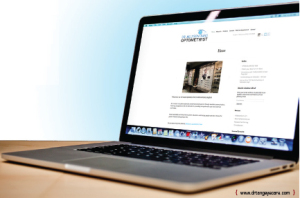 Direct mail proved to be a costly mistake says Tang. “I distributed flyers through the local newspaper and Canada Post. It cost almost $2,000 for 10,000 flyers. If you repeat this every few months it can really add up. And I didn’t get much in the way of results.”
Direct mail proved to be a costly mistake says Tang. “I distributed flyers through the local newspaper and Canada Post. It cost almost $2,000 for 10,000 flyers. If you repeat this every few months it can really add up. And I didn’t get much in the way of results.”
In contrast, Tang’s website (www.drtangeyecare.com) has been an excellent investment. She paid a website developer to create her site and social media accounts with Facebook, Twitter and Instagram. Tang writes the content herself and posts weekly to her website and social media. “I estimate that 30 per cent of our patients find us through an online search.”
Tang will update her website soon. “It will cost around $600. Keeping our website up-to-date and mobile-friendly makes it easy for people on the go to find us.”
Tang has also attended local service group meetings (Lion’s Club and Rotary), visited neighbouring merchants and bought booths at business-to-business expo events (costing less than $200). The Vaughan Business Enterprise Centre offers networking meetings and marketing workshops in which she participates. The Centre also gave her a start-up grant of $5,000, which she used for equipment purchases.
The strip mall in which Tang is located has a mobile sign that merchants can rent for 21-day periods. She first used the sign last summer to advertise a promotion. “It cost around $300 and we captured five new patients with an average sale of $250, so the return on investment (ROI) was good. I have pre-booked the sign for our next high season.”
→ IRIS The Visual Group
Takeaways: Direct Mail, Email, Live Chat
IRIS is a national chain with 163 stores. Direct mail is one of IRIS’ most effective advertising channels, according to Executive Vice-President Daryan Angle. “We mail to our existing customer base and also send offers to specific postal codes. These give us a very measurable return. We market extensively to the AirMiles® database through our affiliation with them, which is another excellent channel.”
Angle points out that every market is different. “You cannot take the same approach in each region. For example, TV advertising is relatively inexpensive in Quebec compared to the rest of Canada, and in some markets radio is affordable. While we have promotions that everyone participates in, we look carefully at how best to leverage that promotion in individual markets.”
“People often can’t say with certainty when you ask them what drew them to your location,” says Angle. “With direct mail we can track the return through bar codes. We also send time-limited email offers to existing customers. These are low cost and have a very high return.”
 IRIS recently implemented customer surveys to assess the likelihood that a customer will recommend IRIS. Customers are encouraged to fill out the survey at the point of sale, and are also selected randomly and approached by email.
IRIS recently implemented customer surveys to assess the likelihood that a customer will recommend IRIS. Customers are encouraged to fill out the survey at the point of sale, and are also selected randomly and approached by email.
The IRIS website (www.iris.ca) has a live chat service for booking appointments, as well as their ‘Ask a Doctor’ feature. The website also has a pop-up questionnaire; upon completion the visitor receives a $50 gift certificate toward a purchase. This is an excellent way to capture useful consumer information and provide an incentive to visit IRIS stores.
“The more helpful information you give customers, the more effective your website will be in connecting you with future customers or reconnecting with existing ones,” says Angle.
→ Karir Eyewear
Takeaways: Social Media, Product Placements
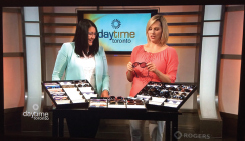 Namita Karir is managing optician at Karir Eyewear Yorkdale in Toronto. The business, featuring artisanal eyewear, was founded 34 years ago and has grown to three locations. Namita, at age 29, is right at the heart of the online generation.
Namita Karir is managing optician at Karir Eyewear Yorkdale in Toronto. The business, featuring artisanal eyewear, was founded 34 years ago and has grown to three locations. Namita, at age 29, is right at the heart of the online generation.
Karir Eyewear advertises twice yearly (their November sale and again on Boxing Day) in major newspapers. “However, we primarily use our website and social media to establish a presence,” says Karir.
A public-relations firm helps Karir keep current by feeding her material to use in social media posts. “I try to personalize each one. We keep our Facebook page very current and I also Tweet regularly.”
Keeping website and social media content fresh, visual and up-to-date is key for Karir. “You have to keep putting in the effort and giving people variety. They are doing their research and it’s your job to keep them excited. Boring simply won’t do.”
Lightbox posters help to attract new customers to Karir Optical’s two downtown Toronto locations. They also send four email blasts to existing customers annually. One of those advertises their annual trunk show, which is a huge draw. “We typically offer an exclusive product or a meet-and-greet with the designer. For example, last year we featured the renowned Israeli designer Ron Arad, who was in town to give a lecture.”
Their PR company also pitches the Karir brand to fashion media outlets. “They get us product placements in fashion magazines, and interviews. This is an excellent spend for us because it builds our brand.”
→ FYidoctors
Takeaways: Google Ads, Facebook, Aeroplan
FYidoctors is a Canadian chain with 190 clinics nationwide and another 100 Vision Source franchise locations. They are now converting all their clinics (except in Quebec) to the common FYidoctors banner.
“In the early days our clinics were each responsible for their own advertising, with access to central resources. Now our advertising initiatives are centralized, while still having local budgets to meet local needs,” says CEO and President Alan Ulsifer.
 FYidoctors is focusing on online advertising. “We have experimented with magazines, newspaper and radio,” says Ulsifer. Three things have risen to the top for us: Facebook, Google Ads and the Aeroplan loyalty program.
FYidoctors is focusing on online advertising. “We have experimented with magazines, newspaper and radio,” says Ulsifer. Three things have risen to the top for us: Facebook, Google Ads and the Aeroplan loyalty program.
“Our Aeroplan relationship lets us communicate with Aeroplan’s 5.5 million members through email and other mediums, to let them know about new products and promotions. This generates the most referrals,” says Ulsifer.
Search engine optimization (SEO) is also helping FYidoctors build their business. Ulsifer explains: “Two years ago we had fewer than 15,000 visits to our website each month; now we get 175,000. That is resulting in patient visits.”
The company has done a comprehensive analysis of online ads from YellowPages and Google Ads. “We found that Google Ads was far more effective,” says Ulsifer.
FYidoctors recently launched a new vision screening mobile app that is building excitement around their brand and will be bringing it to their other databases and all existing patients through email and text blasts.
“We now have a good sense of best practices for our clinics,” says Ulsifer.
“We’ve created the team to manage our advertising program and we make the necessary investments to stay current. You can market all you want and get people through your door but when they arrive, will they make an emotional connection with your brand? We really hope we have achieved that.”
→ Josephson Opticians
Takeaway: Follow your demographic
Optometrist Dr. Josh Josephson sold his private practice 20 years ago and took charge of the optical stores that have been in his family for 80 years. He now divides his time between his six Toronto locations and other business and professional activities.
Interestingly, given the huge changes in advertising over the past 20 years, Josephson hasn’t changed his advertising approach much.
“We’re still in most of the same media and that’s because our clientele is reading those media. Most of our targeted demographic, professionals and entrepreneurs – in fact, anyone who appreciates uniquely designed fashionable eyewear – read the Globe and Mail and Toronto Life magazine. That hasn’t changed.”
 Although the retailer maintains a more-than-respectable website, Josephson says it is harder to reach his specific demographic through online advertising. “Online is more for a mid-or-low market demographic.”
Although the retailer maintains a more-than-respectable website, Josephson says it is harder to reach his specific demographic through online advertising. “Online is more for a mid-or-low market demographic.”
The goal for the website is to help potential clients familiarize themselves with the products Josephson’s carries. “Those who seek out something different or are looking for knowledgeable care hear about us from friends or do their research online before coming to the store.”
Josephson and staff members handle their own creative advertising. “We worked with some advertising firms in the past but we do a better job ourselves. We learned along the way and developed a style. We don’t sell anything that is mass-marketed but instead work with hands-on designers who move the market forward in terms of fashion.”
Josephson advises newcomers to optical retail: “Find local media that present well and get yourself in there as much as you can afford. It’s about building awareness over time, with consistency. Advertising is not simple and learning to make it effective involves a lot of trial-and-error.”
→ Eye Health Centres
Takeaways: Being ‘On Call’, Fridge Magnets
Diana Monea, O.D, has been in business for 34 years and operates three locations – two in Calgary and one in Regina.
She well remembers the ‘bad old days’ of direct mail, print ads and printed newsletters and is happy to be well beyond that now. “New media works better and is less costly.”
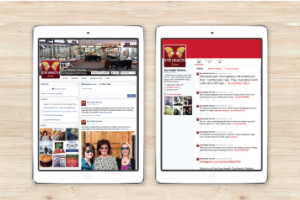 With a strong website (eyehealthcentres.com) and superb social media presence, Monea has never looked back. “We have a web designer who keeps the site current for us. And every associate in the store is responsible for one social media posting each week. Every Wednesday we send out a Tweet and an Instagram post. We use these for sharing information about new products. We also regularly post staff wearing new product. Word of mouth is our best referral source. After that it is our website, and from there it is about equal for Facebook, Twitter and Instagram.”
With a strong website (eyehealthcentres.com) and superb social media presence, Monea has never looked back. “We have a web designer who keeps the site current for us. And every associate in the store is responsible for one social media posting each week. Every Wednesday we send out a Tweet and an Instagram post. We use these for sharing information about new products. We also regularly post staff wearing new product. Word of mouth is our best referral source. After that it is our website, and from there it is about equal for Facebook, Twitter and Instagram.”
Monea’s patients can book appointments online. And the doctor is always available to her patients via email. “One of the things that has really helped build word of mouth for us is that patients can email me 24/7. I receive emails from patients on vacation who have run into a problem with eye infections, for example. If I’m away, one of my associates is on call for email enquiries. I give patients a magnetized business card so they can keep my contact info handy. That’s a great little advertising device!”
Advertising direct to Consumers: Manufacturers prime the pump
Over the last 20 years, there has been a distinct increase in the number of eyewear and lens manufacturers advertising direct to the public. In this article, we’ll look at three of these: Transitions Optical, Essilor and WestGroupe.
Transitions lenses have become one of the most recognizable consumer brands in the optical market thanks to consumer advertising.
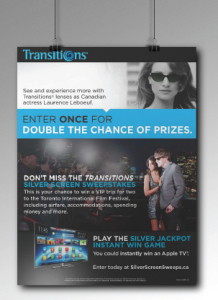 Transitions Optical is spending some of its ad budget on a younger audience these days. “Our research showed that even though the technology behind Transitions® lenses has improved, some younger consumers claim they don’t prefer them because they have an outdated perception of the product,” says Isabelle Tremblay-Dawson, senior marketing manager, Canada.
Transitions Optical is spending some of its ad budget on a younger audience these days. “Our research showed that even though the technology behind Transitions® lenses has improved, some younger consumers claim they don’t prefer them because they have an outdated perception of the product,” says Isabelle Tremblay-Dawson, senior marketing manager, Canada.
Online advertising, TV advertising and social media will combine to help tell a glamorous story about Transitions® Signature™ graphite green lenses to this younger age group. As Tremblay-Dawson points out: “Our Chromea7™ technology story presents an opportunity for us to connect with a younger audience – particularly single vision wearers. We’re partnering with actress Laurence Leboeuf to tell this audience – who are trendy, ambitious, status-conscious and who value technology – about the new colour choices available and the technology advances this product offers.”
“Essilor has been advertising directly to consumers since the mid-1990s, and our investment has increased substantially since then,” says Robert Menes, vice-president of marketing and communications for Essilor Canada. “We started out with smaller initiatives such as ‘brought to you by Crizal’ on the UV report on the Weather Network, leading up to complete national campaigns. Last year we piloted two additional campaigns on Xperio and Varilux.”
Menes says, “Because of our advertising, people walk into the retail experience with awareness; either they ask for the products or they recognize them when the eyecare professional (ECP) brings them to their attention. Advertising definitely helps drive consumer demand and acceptance.”
Essilor measures the response to every campaign through market research. They do brand recall surveys (i.e. asking, ‘Have you ever seen an ad for this product?), and awareness surveys (i.e. ‘Tell me about the lens brands you are aware of ’), and also measure web traffic and can see how many viewers are looking for local ECPs, for example.
Once consumers come into the store, ECPs can reinforce Essilor’s advertising by showing video loops of the TV advertisements on in-store monitors. Essilor also supports individual ECP advertising with pre-formatted content for Facebook, print ads and radio.
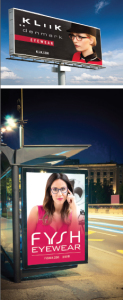 WestGroupe began direct-to-consumer advertising in 2011 for Evatik, their frame collection for men. “Our national outdoor campaign included billboards and transit shelters across the country,” says Beverly Suliteanu, vice-president of marketing and product development. “Although consumers may not have gone to the ECP asking for Evatik, many did recognize the name when they were shown the collection.”
WestGroupe began direct-to-consumer advertising in 2011 for Evatik, their frame collection for men. “Our national outdoor campaign included billboards and transit shelters across the country,” says Beverly Suliteanu, vice-president of marketing and product development. “Although consumers may not have gone to the ECP asking for Evatik, many did recognize the name when they were shown the collection.”
WestGroupe has websites for each of their three proprietary brands: Evatik, Fysh UK and Kliik denmark. Each site features engaging videos. “All of our websites are designed for both consumers and the trade and have components geared to each audience,” says Suliteanu. “The videos are a great way of creatively telling our story.”
Each brand also has its own Facebook page and is supported by social media platforms, including Twitter and Instagram. “It’s all about engaging with those who connect to our brands,” says Suliteanu.
“Consumer advertising supports our retailers and increases sell-through of our brands,” notes Suliteanu. “There is a definite synergy in that. Without the distribution, the consumer would not be able to purchase our products and, without consumer awareness, it would be much harder for the retailer to sell our products.”




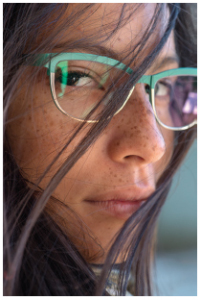
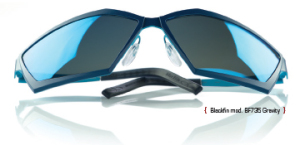 Rosson, vice president of product and design, heads a team of four, all of whom are responsible for innovation. “We have patented many innovative solutions over the years – some aesthetic, some technical,” says Rosson. “For example: the ATOM ZERO screwless hinge can be opened and closed more than 50,000 times without becoming slack. Our SWORDFISH temple tips with break-off guides make it possible to shorten the temples by five or 10 mm in three simple moves without using any instruments. The SHARKLOCK glazing system makes it possible to fit the lenses into the 0.5-mm beta titanium inner rims without the need for screws. This is the result of the special “sharks-fin” grooving in the rim, lined with a thin sheet of metal, enabling the lenses to be locked into the frame simply with the aid of a screwdriver.”
Rosson, vice president of product and design, heads a team of four, all of whom are responsible for innovation. “We have patented many innovative solutions over the years – some aesthetic, some technical,” says Rosson. “For example: the ATOM ZERO screwless hinge can be opened and closed more than 50,000 times without becoming slack. Our SWORDFISH temple tips with break-off guides make it possible to shorten the temples by five or 10 mm in three simple moves without using any instruments. The SHARKLOCK glazing system makes it possible to fit the lenses into the 0.5-mm beta titanium inner rims without the need for screws. This is the result of the special “sharks-fin” grooving in the rim, lined with a thin sheet of metal, enabling the lenses to be locked into the frame simply with the aid of a screwdriver.” Bélanger notes that Blackfin meets the need for metal frames in a market over-saturated with acetate. “The frames have a lot of character, making them present on the face yet very comfortable and light. And the colours are amazing, in just the right shades and combinations.”
Bélanger notes that Blackfin meets the need for metal frames in a market over-saturated with acetate. “The frames have a lot of character, making them present on the face yet very comfortable and light. And the colours are amazing, in just the right shades and combinations.”


 IRIS recently implemented customer surveys to assess the likelihood that a customer will recommend IRIS. Customers are encouraged to fill out the survey at the point of sale, and are also selected randomly and approached by email.
IRIS recently implemented customer surveys to assess the likelihood that a customer will recommend IRIS. Customers are encouraged to fill out the survey at the point of sale, and are also selected randomly and approached by email.





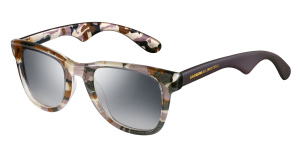

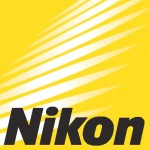
 Plan “B” Eyewear’s glamorous new Glacée models play on a vintage style. Bold frame shapes meet colourful patterns and textures to create a look that is unique. Model 6731 features retro geometric, snake and stone patterning, while the 6734 frame uses a precise painting technique to create the illusion of rhinestones and shimmer, and all, feature fascinating patterns. Finally, model 6736 goes for sleek, shiny colour, mixing purple with mint and orange.
Plan “B” Eyewear’s glamorous new Glacée models play on a vintage style. Bold frame shapes meet colourful patterns and textures to create a look that is unique. Model 6731 features retro geometric, snake and stone patterning, while the 6734 frame uses a precise painting technique to create the illusion of rhinestones and shimmer, and all, feature fascinating patterns. Finally, model 6736 goes for sleek, shiny colour, mixing purple with mint and orange.
